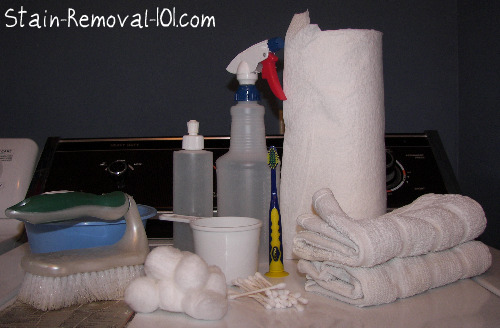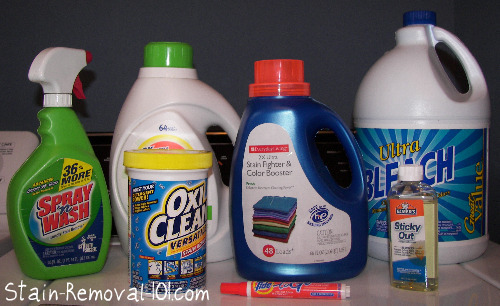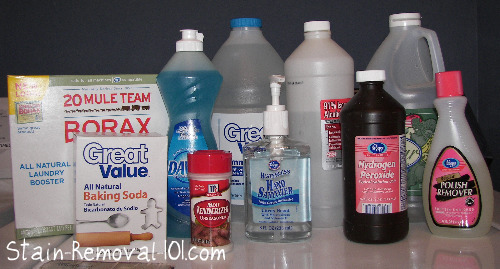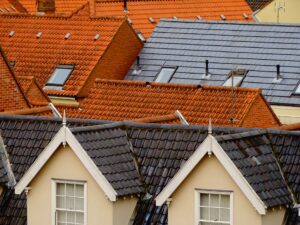The following is a guest post from Taylor at Stain-Removal-101.com and Household Management 101:
As the Mommy to three young children, I inevitably find stains on the clothes whenever I do laundry.
In the past, I would just grab a commercial stain remover, spray it on and hope for the best no matter what the stain was.
Sometimes this worked, and sometimes it didn’t.
Different types of stains need different types of treatment, which can get pretty complicated. Who has time to research the best method for stain removal for lots of different types of stains and then go out and buy products just for that one stain when we just need to get the underwear washed?
That’s when I hit upon the idea of creating a laundry stain removal kit to keep in my laundry room. The kit contains basic stain-removal tools and household items, all within easy reach. With this kit, I can treat the main types of laundry stains for the main types of washable fabrics quickly and easily without hunting all over the house for what I need or needing to run to the store for a specific stain remover.
Below is a list of items to help you create your own stain-removal kit. Pick and choose the items that will be most useful for your family’s laundry and stain removal needs.
In addition, if you make some or all of your own cleaning products, many of the supplies and products listed overlap with those in this kit, so you can create a dual stain removal and cleaning supply kit.

Table of Contents
Laundry Stain Removal Equipment
Here is the equipment and supplies I recommended for your kit:
1. Big tub or bowl:
This is something you can soak the clothing in (unless you have a large laundry sink, which, unfortunately, I don’t). I also use the tub to hold all the contents of my kit.
2. Small bowl:
Sometimes you just need to soak something small or mix up a stain removal solution, and a small bowl is perfect.
3. White paper towels or white cloths:
There are so many uses for these in stain removal, including blotting up excess spills and blotting on stain removal solutions you create for treating stains. I specify white because you don’t want dyes in the paper towel or cloth to transfer onto the garment you are treating and cause a new stain.
4. Spray bottles and squeeze bottles:
Use these to hold the stain removal solutions you create (label them if you are using them long-term) and apply the solution to the stained area. A spray bottle is used when you are covering a large area, and a squeeze bottle is best when you need to saturate a smaller area.
5. Eyedropper:
Use this to apply a very small amount of stain remover to a stain in situations where you want to limit how much area a remover gets onto the fabric.
6. Cotton balls and q-tips:
These are handy for dabbing a small amount of a stain remover onto a stained area when you don’t want to dirty an entire white cloth or want to be precise in where you are applying the remover.
7. Measuring cups and spoons:
Have some dedicated measuring utensils for creating your stain removal or cleaning solutions to help you measure correctly. You don’t want to use the ones you will be using for cooking because of the chemicals.
8. Old toothbrushes and sturdy brushes:
One of my favorite stain removal tools is an old toothbrush that I use to gently rub the stain remover into the stain, to help manually remove it from the fabric fibers. Sometimes you also need a sturdier brush for tough fabrics with large stains, like jeans.
9. Stain removal chart:
Don’t try to guess what stain removal solutions to create or what method to use to remove a particular type of laundry stain. Instead, consult a stain removal chart that you keep handy in your laundry room for quick reference. I have my one-page chart laminated and consult it all the time for quick directions on how to remove the most common spills and stains.
You can get your own copy of this free printable laundry stain removal chart at my website, Stain-Removal-101.com, when you sign up for my free newsletter, Out Darn Spot!.
 Commercial Laundry Supplies
Commercial Laundry Supplies
Here are the commercial laundry supplies I typically use for stain removal.
I don’t actually keep all of these in my stain removal kit because several of them are on a shelf for everyday use as I do my laundry.
1. Laundry detergent:
Either liquid laundry detergent or powdered laundry detergent combined with a little water to make a paste is quite effective as a pretreatment stain remover for many common food stains. In addition, assuming the detergent contains enzymes, it is also useful for many protein-based stains such as dirt and mud, milk- and cream-based stains, and bodily fluid stains that most parents are familiar with.
Did you know that most commercial laundry detergents contain enzymes that help break up protein-based stains? However, if you make your own laundry detergent, you will need to add some enzymes to treat these types of stains (see below for a home remedy enzyme treatment for your clothes).
2. Laundry stain remover:
I like to use a laundry stain remover for many types of food-based stains just because it is quick and easy, and it is already premade and ready for me to spray onto the stain and throw into the washing machine. Laundry stain removers, of course, come in many varieties, such as sprays, pens, and sticks. In addition to commercial products, there are also homemade alternatives you can use too, some of which are discussed below.
3. Bleaches:
Chlorine bleach, all-color bleach, and oxygen bleach can all be very useful in getting rid of stains from your laundry, either by adding them to the wash or presoaking the clothing in a solution of bleach and water.
Did you know that bleaches don’t actually remove the stain but instead just remove the color from it so that it becomes invisible to the eye?
4. Dry cleaning solvents and spot removers:
These solvent-based liquids break down oils and grease and also are useful for non-water soluble stains. It is best to apply just a small amount to the fabric at a time, as this is more effective than dousing the fabric with the solvent. Make sure to completely rinse out the solvent after removing the stain and before washing the item. You also need to use them in a well-ventilated area.
Homemade and Frugal Stain Remover Supplies
Below are the products I use to create homemade stain removers.
These products are generally inexpensive, especially when you buy the store brand instead of a name brand (as you can see I try to do from my picture), and also when you buy in bulk.
Buying in bulk is especially economical if you also make your own cleaning supplies because many of the items pictured here are the same for creating both stain removers and homemade cleaners.
In addition, most (not all) of the products listed below are natural, so they are safer for the environment and for you and your family.
Although I do use some commercial products, I try to use as many homemade and natural products as possible when removing laundry stains.
1. Baking soda:
Baking soda can be a gentle laundry booster when added to the wash. In addition, it (or cornstarch) can be used as an absorbent for greasy stains. Just sprinkle the baking soda onto the greasy stain and let it sit for 15-20 minutes to absorb the oils and then scrape it away.
2. Borax:
Borax is also a natural laundry booster and can also be used as part of certain homemade stain remover recipes. One way borax works is by softening the water, thereby allowing the detergents to work better on your clothes. Borax is also great for soaking cloth diapers. Besides cleaning, Borax can be used in crafts.
3. Dishwashing liquid:
A bleach-free, lanolin-free mild dishwashing liquid like Dawn can work wonders on oily and greasy stains. Since it can cut grease from your dishes, it can do the same on your clothes. Just rub a little dishwashing liquid into the oily stain with a toothbrush and then rinse away both the soap and oil from your fabric. I have personally never had a problem using a colored dishwashing liquid when removing stains. Still, some people caution using only clear dishwashing liquid for stain removal so you don’t accidentally get a stain from the soap itself.
4. Meat tenderizer (unseasoned):
If your laundry detergents or stain removers do not contain enzymes, you will need to add some when treating protein-based stains like blood, milk, and grass. You can make a paste of unseasoned meat tenderizer and water and apply this to the stain for approximately 30 minutes to help break down the proteins within the stain, and then brush off the paste and launder. Another source for enzymatic treatments for your stains is to use contents of digestive enzyme tablets that you can purchase at health food stores.
5. Ammonia:
Make sure you use the non-sudsing, non-scented variety of ammonia for stain removal. Ammonia, as a mildly strong alkaline solution, can be helpful for removing some really stubborn stains like dried blood, sweat, pen ink, and urine stains. Always test in an inconspicuous area before applying to the stain (generally in a diluted form), and never mix with chlorine bleach, as toxic fumes can result.
6. White vinegar:
White vinegar is a mild acid and is helpful for neutralizing odors and also for removing many types of food stains. Vinegar has become a very popular laundry additive in recent years, too, because it can help ensure all detergent is thoroughly rinsed from the fabric, and it helps soften clothing without using commercial fabric softeners. Please note, however, that repeated exposure to vinegar will slowly weaken certain natural fabrics, such as cotton, because of its acidic nature.
7. Rubbing alcohol:
This stain remover works well to remove ink and also for stubborn berry stains, among others. In a pinch, you can also use waterless hand sanitizer for oil and grease stains and then rinse with warm water.
8. Hydrogen peroxide:
Be sure to use 3% hydrogen peroxide, the kind sold in the brown bottle for first aid, not the stronger version sometimes used for hair bleaching. Hydrogen peroxide is a natural bleaching agent that works similarly to oxygen bleach. It can be helpful in removing blood and chocolate stains, especially. It can also be used as an alternative to chlorine bleach in the wash as a natural whitener. Always test it in an inconspicuous area before applying it to the stain to check for colorfastness.
9. Nail polish remover:
Nail polish remover is definitely not a natural product and generally contains acetone. However, it can be used to remove such stains as nail polish or correction fluid, like White-Out, from clothing. Do not use it on fabrics containing acetate, rayon, silk, or wool because it can harm these fibers (it will literally melt acetate). It should also be used in a well-ventilated area only. Always test in an inconspicuous area before applying to the stain.
I hope these ideas will help you in creating your own laundry stain removal kit, taking what works for you and leaving the rest behind.
As you can see, different stain removers are used to remove different types of stains from various fabrics. This information merely scratches the surface of what you can use to remove laundry stains.
For step-by-step instructions on removing all kinds of stains from washable clothing, upholstery, and carpet, check out my A-Z Stain Removal Guide.
What items do you use for stain removal? Do you have a kit set aside for these products?
Taylor is a mom of three, eight years and under, who enjoys playing with her kids, reading Harry Potter, cross-stitching, and figuring out how to get rid of stains as quickly and easily as possible so she can get onto more fun things. She blogs at Stain-Removal-101.com and Household Management 101.





